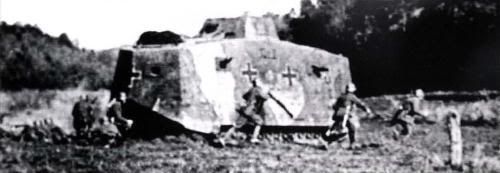After Cambrai, Armee Kraftwagen Park 2 (AKP2) was assigned to create the Tankbergungsstelle Cambrai and to recover as many tanks as possible. The recovered tanks were sent by rail to Charleroi to be rebuilt by Bayerische Armee Kraftwagen Park 20 (BAKP20). 28 tanks are said to have been shipped to BAKP20 and by the end of March 1918 10 tanks were restored to working condition.
A few pages later: “with the steady flow of newly captured tanks becoming available from Charleroi, the captured-tank units were refurbished with new tanks for the 3rd Army attack near Souain on 15 july 1918”.
After the spring and early summer fighting some 300 British tanks were left behind German lines. 85 of those were sent to BAKP20 at Charleroi and 48 were canniblised in the field for spares. An estimate of early August 1918 states that some 170 British tanks were available for rebuilding. That number was beyond the capabilities of BAKP20 and civilian firms were contracted for rebuilding work.
The book in question is an Osprey book of their New Vanguard series. Though informative it is sadly lacking in consistency and details.
All in all it looks like a few hundred were captured but how many were rebuilt? At least thirty for the 6 Abteilungen that were armed with 5 tanks each and some replacements. My guess would be that no more than 60 were actually rebuilt but I can’t be sure of that. A quick internet search revealed nothing more exact or explicit either.
Here’s one more picture of the A7V as it was intended to be used. Together with troops of a Sturmabteilung racing over relatively flat terrain. The British tanks were too slow for this job but the A7V could manage almost 15 km/h (9 mph) until it reached a trench.


